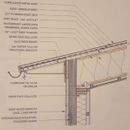Eave detail
Hello again! For the most part I’m pretty confident in this wall/eave detail, but I’m open to criticism.
My main concern is the long term viability of the “exposed” membrane above the IJoists. I haven’t called it out specifically, but I’m assuming it’s a fancy vapor item WRB of some kind.
Along the lines of a recent post here regarding longevity… is it foolish to leave the WRB in the open here? The intent is to create a cold roof.
GBA Detail Library
A collection of one thousand construction details organized by climate and house part










Replies
Ethan,
A couple of things seem unclear.
- The structural brackets help support the cantilevered 2"x4's on the flat, but what supports the structural brackets? How is the loading carried back to something solid?
- Where is the intake for the outside air at the eaves? The blue arrows show it entering at the ends of the structural brackets, but is there some soffit material above you haven't called out? What do you see when you look up at the overhangs? The 2"x4"s and plywood above?
Malcolm, thank you. I have to better think through the eave brackets and venting.
Ethan,
Malcolm identified the basic problem: In Climate Zone 5, I assume you have snow. The snow (or the person standing on your roof to check the gutters) will cause the eave to collapse. You need some type of structure under your plywood overhang.
Martin, thank you, I'm looking into that. Assuming I have a magical TBD eave support, is the rest of the detail to your liking?
Ethan,
Assuming you come up with a structural support for your roof overhang, and assuming you remember to provide vent openings for your soffit vent, everything looks good.
Ethan, overall I think you have a good assembly. A few notes, though:
TJI rafters need at least 1 3/4" bearing on the bottom, web stiffeners and solid blocking the full height of the rafter.
If the roof sheathing is not in contact with the rafter, you might need another way to brace the roof structure. Some code enforcement officials and engineers are ok with 2x furring in between, most are not. I think it's fine if you're not in a high-wind or seismically active zone and you are careful about fastener size and placement.
Tape your roof WRB to the wall WRB, so it's a bulletproof connection, don't run the roof WRB over the top of the rigid foam. You can add a piece or tape to cover the top of the foam if it's absorbent (EPS or Polyiso).
Pro Clima Solitex Mento Plus and Siga Majcoat are WRB's made for this application.
Run your wall furring to the top of the frieze so your siding is back-vented and you have more solid attachment for your frieze. If you do that, I would not worry about the overhang, up to 12" and possible more.
Either change to board sheathing at the overhang, or run decorative soffit boards of some sort under the 2x4 look-outs, before installing your brackets.
How do you propose to handle the rake overhangs? I've used similar assemblies often and the rakes make things complicated, unless you eliminate the overhang at the rakes.
I'm wondering what are other options for roof bracing with 2x furring?
Ethan,
One obvious possibility is to use two layers of roof sheathing -- one below the ventilation channel, and one above the ventilation channel.
Ethan, double-sheathing is one option. Or you can use Simpson strap bracing. Or sheathe the bottom of the TJI's instead of the top. Or run your ceiling strapping on a diagonal instead of orthogonal. Or use smaller TJI's (you'll find 16 inchers are a jump in price compared to 14 inchers anyway) and install your assembly above another layer of roof framing and sheathing, in more of an outrigger or Larson truss arrangement. Depending on where you are located, any of these may require an engineer's stamp, or your CEO may be fine with your original assembly.
Michael, thank you, I'll look into those options. Martin, it seems to me that the option that includes two layers of sheathing recreates the cold sheathing problem that I was originally trying to solve with this assembly.
Ethan, if the bottom layer of sheathing is CDX and you have a variable-permeance membrane at the interior, double-sheathing is generally a safe assembly, as any moisture that accumulates in the sheathing can easily dry to the exterior. It's not as vapor-open as your original, "sarking membrane" approach, and it's somewhat more risky with OSB sheathing, but it can work even with OSB.